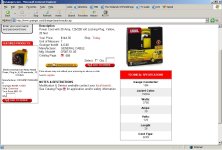<font color=green>The generator has one 50 amp 220 outlet, two 10 amp 110 outlets
Would my two 10 amp outlets have enough power to run a fridge, freezer, and furnace, for example, without exceeding the amperage?</font color=green>
<font color=blue>That might be pushing it. My freezer and fridge each pull 8 amps at start up and my furnace pulls 5 or 6. That's 21 amps. Add the sump pump you mentioned, and it'll pop the breaker.</font color=blue>
After looking more closely last night, I see that I mis-spoke slightly. There are two 110 receptacles, and underneath them is a single label that says "20 Amps." I guess I was thinking 10 each, but I suppose maybe it's 20 amps collectively.. i.e., one could perhaps put out the 20 amps if the other wasn't doing anything. Either way, it seems a shame to waste the potential of putting out the full 70 amps the genset is capable of.. so something else would probably work better.
One thing puzzles me. I would think, given the risk to the power company linemen if someone miswires something like this, that the power company would bend over backwards to help folks out when it comes to installing gensets. It might even pay them in the long run, in terms of both safety and customer relations, to provide the switches needed and whatnot. After all, we'll only need these setups if they fail to provide the power we pay them for. So it would be a win/win situation if they did something like this for the tiny percentage of customers who actually have generators. Just thinking out loud here.. but maybe I should call the power company and see what stance they take about these things?
Thanks again for all the advice, folks, and sorry to have created the record monster thread! /w3tcompact/icons/smile.gif
Bob


